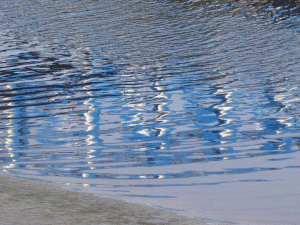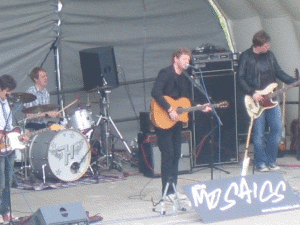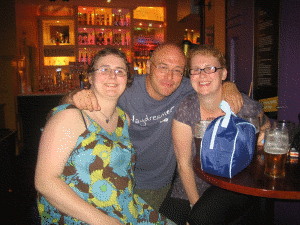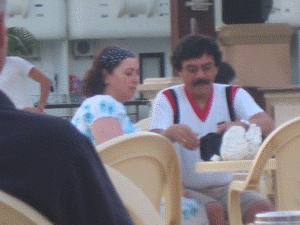Sunday 29 July 2007 22:45
After giving my newest laptop to Rhiannon I realised that my ipod would need to communicate with either my old laptop or the computer in the corner of the living room. The problem is that neither have a CD drive or a copy of the software I used for the ipod (no, I couldn't bear to use i-tunes). I can get around the first problem by ripping CDs using freerip on the kitchen computer and copying to the living room computer using a portable hard drive (it sounds a lot more hassle than it really is). Fortunately, I've now managed to find a solution to the second problem, in the form of Yamipod. It's free and it works. I've just used it to copy the Mosaics' album to my ipod. Both the program and the album are great; go download one and buy the other.Sunday 29 July 2007 18:09
From the Eels website:MARK OLIVER EVERETT WRITES BOOK:
Where have Mr. E and the EELS gone? There hasn't been a single sighting since the conclusion of the 2006 LIVE AND IN PERSON world tour and the few stray appearances soon after. We're not getting a lot of info here at the EELStheband.com offices, but we do have this enticing new bit of news: EELS leader Mark Oliver Everett has written a book about his life, to be published in 2008. That's all we know so far. Stay tuned for more news as it comes.
Sunday 29 July 2007 16:29
Something I'd forgotten from yesterday. While we were sitting outside the Roker hotel on the sea front, partaking of refreshment while watching the airshow, Sunderland's Sun FM were broadcasting live. At one point, there was some mindless banter between the two DJs, with some discussion of the following day's events. Apparently, being Sunday, it was going to be a very relaxed day. The conversation continued along the lines of:
Male DJ: Tomorrow's going to be even more laid-back than today.
Female DJ: Even more than today? It's been really laid-back today.
Male DJ: Yes, even more than today.
Female DJ: Then I'll be so laid-back I'll almost be vertical.
With a bit of luck there'll only have been a couple of thousand listeners.
Sunday 29 July 2007 00:54
I cycled to Lucy's today; took her other bike to her house. I was quite pleased with myself since I managed the ride to Sunderland in half the time it took last time around. Might have been down to the girl's saddle on the first bike though. After leaving the bike secured to the wheel of Ian's car I went to (day one of) the Sunderland airshow.(ok, so it's a ship)
I guess I have to show the obligatory Spitfire picture; I'm not knocking history, but it's so 1966 isn't it?

Tuesday 24 July 2007 22:11
Today wasn't great; I had a filling replaced. It was still under guarantee though, so I guess there's a positive in there somewhere. Or is it a major negative because the original filling resulted in repeated pain and discomfort?
Anyway, yesterday was a much nicer day. I went for a bike ride along the Tyne. I went a lot further than I'd intended, and as a result suffered a little on the return leg. but thoroughly enjoyed myself.
My bike on the Tyne bridge ...

It's funny how you can find things on your doorstep when you look. Cool, eh ...

And even more so when something you'd think of as ugly can look great ...

Yes, it's mud. I'll have to explain the next one though. It looked better on the day, and in a larger picture, but this one shows the reflection of the Metro bridge in the river. I could have taken a picture of the bridge itself, but the reflection was a lot nicer.

Monday 23 July 2007 01:43
Although everything was very on the spur of the moment, I've had a great Sunday. We went to see the Mosaics and Seven Heroes in a park and it was all very festival-ish. I even bought the Mosaics' album (We'd been waiting for that for weeks though).

Afterwards, my children dragged me off to Sunderland and forced me to consume beer. Naturally, I tried to resist, but my efforts were in vain. Tonight was great though; I love my children to bits.

Almost forgot. I was talking to a girl in a pub this afternoon; she said, 'I've see the picture on your desk at work, is it Sophie? I didn't realise that you knew her until I saw you with her mother'.Spooky, eh? Even more so when I'd only just had a telephone conversation with said child.
Saturday 21 July 2007 22:12
Ms Artois and I are currently snuggled up on the sofa, listening to music and pondering life, the universe and everything (yes, I know the answer's 42). Anyway, while on the subject of such things, how cool (albeit questionable) is this? ...
Hugh Everett III and the Many Worlds Theory
A Branching Out of Many Worlds (chapter ten)
Our
known universe is defined by two transformations. In the first all the
strange and chaotic futures we might imagine do not happen because of
nature's consistent laws and forces. Primarily gravity,
electromagnetism, the strong force, and the weak force, remove from
possibility all of what we would think of as weird or irregular events.
The forces of nature create a wonderfully predictable world where the
sun rises and sets each day.
However,
if we think about it, we can reason that there must be many other
unique morning and evenings that don't happen here in our own world,
and all are reasonably as possible as the one world we experience. Why
don't they exist? Do they exist elsewhere? If we utilize the same laws
and forces of nature, we can conceive of many other paths of time, or
many tomorrows, all happening in other worlds.
Each
one of us who has ever contemplated the universe has at one time
wondered why our one world would exist when all the others as equally
possible never made it to the party. It is when we study quantum
mechanics that we find nature acknowledging all those other worlds that
are equal in possibility to our own.
What
is imagined as possible by science, beyond the one world we experience,
increased significantly after we discovered that all the small
particles that collectively construct our world travel through space as
probability waves. Instead of traveling from point A to point B like a
thrown baseball, today we understand that light behaves in some ways
like a solid particle when it interacts with other particles, however,
when light travels from place to place, like a wave in an ocean it has
no definite position. In fact, even matter particles, such as the
particles that make up our bodies, regularly disappear between one
position and the next.

Below in the split screen experiment the wave of a single particle passes through two slits, then upon recombining the two waves interfere with one another. The resulting interference is virtually identical to the interference caused when two waves on the surface of water interact after they pass through two openings in a wall. The two waves colliding together add up in some places and cancel in other places.

One
of the founders of quantum theory, Werner Heisenberg discovered what is
now a key principle concerning all quantum behavior. As a particle
gives up information about its location, information about its momentum
is lost in equal measure. This is called the Heisenberg uncertainty
principle, which states that both the position and momentum of a
particle cannot be known. The more we know about one, the less we know
about the other. So as a rule, whenever a particle assumes a precise
position in reality, in that instant it has no momentum. And whenever a
particle is moving from one place to another, it has no specific
location. Only when the particle interacts with something else does it
then establish which physical reality we will experience, but in
between interactions the particle exists in another type of reality, a
sort of multiplicity where all possibilities are combined together.
Quantum
theory was developed near the turn of the century and it wasn't until
1957 that all the possibilities within each quantum wave led a young
graduate student of physics named Hugh Everett III to produce the now
famous Many-Worlds Theory as his doctorate thesis. Everett was a
student of John Archibald Wheeler, the renowned American physicist and
longtime Professor at Princeton. The Many-Worlds Theory makes the
simple conclusion that one probabilistic outcome is as real as any
other, predicting an immense surplus of many-worlds branch away from
each moment of now.
We
can imagine an infinite number of copies identical to our present, but
then in the next moment, in each copy there is one single particle that
is in a slightly different position than all the others. The denser
areas of probability in the interference pattern represent the more
probable worlds, while the thin areas represent the least probable
worlds. The areas outside the wave pattern that are completely dark can
be thought of as worlds outside the realm of quantum possibility.
The First transformation
There are two basic transformations occurring in every moment of every
day which are inevitably built into the unfolding of time. In the first
transformation, the majority of bizarre futures one might find in the
imaginary stories of science fiction, horror, and fantasy tales are
erased from possibility. This boundary between what is possible and
impossible is created by what we otherwise know as the laws and forces
of nature. The forces of nature control and define the areas that
matter particles can move about within. Forces are simply the shapes of
probability waves, and those shapes bond particles together, in groups,
in lattices, in symmetries. Once this first transformation is complete
there are still many different tomorrows possible that abide by
nature s rules. We can imagine all sorts of different events that
could possibly happen in the unfolding of each new day. The quantum
wave is essentially all the other worlds that are equal in possibility
to our own.
This
first transformation is probably best described by the Sum Over
Histories method of mathematically determining the shape of the
probability wave, which was developed by Richard Feynman. Feynman's
original highly creative approach doesn t merely consider the
expected classical paths of particles, it mathematically sums every
conceivable path through time and space, even those that disobey the
laws of physics, so a particle zig-zags from left to right, and loop d'
loops irregularly in all directions, irrespective even of past and
future. Yet when every conceivable path is considered and the amplitude
of each is summed up, the irregular waves end up canceling one another,
while only the expected waves that abide physical laws remain. For some
unknown reason, when all conceivable histories are summed all that
remains are the possibilities of everyday life.
Quantum
mechanics led physicists such as David Bohm and John Bell to argue that
the wave-particle duality signifies a deep interconnectedness in
nature. Where Bohm developed concepts such as implicate and explicate
order to explain the wave particle duality, Bell explained that no
complete explanation of the quantum behavior of particles is possible
within what we normally think of as the physical universe. Bell's
theorem argues that quantum mechanics involves a non-local process. In
other words, some non-local process shapes the world we live in.
The Second Transformation
The first transformation eliminates all the weird or abstract worlds we
might find in a horror movie. The second transformation is when the
multiplicity of possible worlds transforms into the single world we
live in. We only experience one world at a time. But what causes this
second transformation to happen? Exactly when does it happen? We
naturally expect this second transformation occurs as a solid and
definite past rolls into an indeterminate future. Only that isn t
how things work at all. Instead the past is also a wave of probability.
Nothing
reveals the inevitable existence of Many-Worlds more vividly than the
story of Schrödinger's cat. To illustrate how the absurd
multiplicity of the quantum wave effects the unfolding of physical
reality, the physicist Erwin Schrödinger created a vivid thought
experiment where he places an ordinary cat within a delicately rigged
box. Inside this box there is a radioactive atom that is in a
probabilistic state of decay. The atom has a fifty percent chance of
decaying within a short duration of time, a half life, of about five
minutes. If this atom should decay it will expel a single electron
particle that will register on a Geiger counter, also inside the box,
and upon detection a hammer will break a glass vile of cyanide gas,
instantly killing the cat, that is, if the particle decays. So the door
is shut on this contraption and we wait five minutes.
We
know from quantum mechanics that until we open the box, in the same way
the photon travels through both slits, the atom remains in a wave-like
state of multiplicity where after five minutes, in half of all possible
worlds it has decayed and in the other half it has remained stable. In
fact, until there is a deterministic outcome which we create by opening
the door and observing the contents of the box, the atom exists in both
states simultaneously. Schrödinger pointed out that since the atom
remains in a wave-like state of nothing but probability, as odd as it
seems, the wave extends to the Geiger counter inside the box, which
also exists in a wave-like multiplicity of having detected the decay
and opened the cyanide in half of all possible worlds, and having not
in the other half, which further means that the seemingly single cat we
placed in the box is somehow simultaneously alive and dead.
Of
course this cat-unfriendly experiment has never taken place, it serves
only to scientifically dramatize how quantum mechanics, one of the most
successful theories of science, extends to the larger macrocosmic world
of cats and people, and in so doing it forces us to dramatically change
how we imagine the world around us.
The
state of the cat can be interpreted in one of two ways, both of which
define reality in dramatic fashion. In the Copenhagen interpretation we
say the decaying atom is in a wave-like state and so is not real, it is
just probability, meaning that it has neither decayed nor remained
stable until we open the door of the box. But what about the experience
of the cat inside the box? If the atom somehow isn t real when
wave-like, then the cat isn t real either, it s neither dead
nor alive. But is this idea acceptable? It is one thing to imagine a
particle isn t real if a human being isn t observing it, and
another to imagine a cat needs to be observed.
Believe
it or not, there are some who egocentrically claim that only humans can
create reality. The Copenhagen interpretation led one physicist to
remark that the moon doesn t exist when no one is looking at it.
Of course if someone is arrogant enough to claim that the cat s
observations aren't independently real, the next hypothetical step
would be to place that person in the box and start the experiment over.
In
the Many-Worlds version of Schrödinger's cat we don't try to avoid
the idea that beyond our vision two realities exist simultaneously, so
we say the particle has decayed in one reality, and remained stable in
the other reality, and two superimposed conflicting realities exist.
But neither reality is yet connected in a definite way to an observer
standing outside the box. Instead the experiment has created two cats,
one is dead and one is alive. Then when we open the box to observe the
dead or alive cat we collapse the wave and connect ourselves to one of
the two realities. Note however something that is really strange here.
The outside world as we open the door to observe the cat, and so we
ourselves, split into two principle realities. In one we exist
observing the cat alive and in another we exist observing the cat as
dead. What this means is that we split into two different realities in
the future because behind the door there are two different pasts.

When
we imagine the future we usually see it as potential. Some people state
that anything can happen although we don t expect much of anything
will happen, we expect the ordinary, but we at least imagine that the
varied possibilities of the future grow greater with a greater period
of time. What might happen tomorrow is rather limited compared to what
all might happen in a year or a decade. But we think the infinite
possibilities are out there in the future. As it turns out, the past is
also probabilistic. Quantum mechanics suggests that anything we
haven t yet observed, everything happening in another state or
country, everything happening a mile away, literally everything in the
world beyond our five senses, is in a quantum state of multiplicity.
The infinite isn t out there in the distant future. It is just on
the other side of any door. It is just beyond our vision, our hearing,
our touch, our smell. It is everything we don t know. If we
haven t yet read the news of the day, all the possible newsworthy
events are happening simultaneously in alternative universes waiting
for us to turn each page of the newspaper, and only then do we connect
with one of those worlds.
Some scientists shrug at the Many-Worlds Theory and continue to believe there is something that makes quantum reality operate only at the subatomic level, and not at a macrocosmic level where we live. But the technological applications of quantum mechanics to chemistry and electronics have already had a tremendous impact upon society. In addition to television shows and movies where characters cross over into parallel universes, physicists are working toward a complete quantum description of reality. If a complete theory is ever accomplished, it will explain why certain things are possible while others are less so, and it will tell us what is impossible. Presently, the Many-Worlds Theory does not claim that other worlds with different laws and forces of nature cannot exist, but if the probabilities of quantum mechanics were found to be basic to nature then we would reasonably conclude the same laws govern all of existence.
The uneducated may ask, 'who on earth is Hugh Everett III ?' He's, or rather was, the father of Mark Oliver Everett, E, of Eels. Have a listen to Eels' Things the grandchildren should know for more information.
Saturday 21 July 2007 19:16
REDACTED
Thursday 19 July 2007 23:26
It's been a busy couple of weeks; unfortunately mainly a result of work. But at least the weather's been horrible, so I've not really missed anything. The sun was shining in Liverpool, and even Preston, today though. Even though it was only a case of walking from one office to another, the sunshine in Liverpool was nice. At least it was until I saw everyone sitting outside the Goose with ice cold beer. Still, it's amazing how, when you're feeling really tired after a few meetings, how much better a place the world is when someone buys you an ice cream.
Oh, we've been on holiday too. It already seems such a long time ago. Anyway, this is where we stayed in Marmaris.

We made an important discovery while we were there too. Although it's widely believed that Saddam Hussain was executed a few months ago, we found that he is in fact alive and well and living in Turkey.

Sunday 8 July 2007 00:59
After a quite stressfull night in the Tyne Bar (there was a girl on something I'll not even imagine and a very odd looking man with a large, concealed knife in the toilet ... and probably beyond the toilet), we decided to call in at the Tuns for a last drink. We arrived by cab from the Quayside and I went straight to the bar while my spouse went to the toilet (I'd previously visited some bushes because men apparently have weaker bladders).
I started talking to Paul (the landlord, as usual) and halfway through the conversation about the madman with the knife and my potentially near death experience Paul mentioned that Gandalf was in the bar. I looked in the direction in which Paul was looking (next to me) and saw an old-ish bloke with a beard and wearing a baseball cap. I'd have probably have believed him if he'd not said ' ... and that's Sylvester McCoy over there'. So I didn't take a phone picture of me with my arm around Sir Ian McKellan or Sylvester McCoy, unlike everyone else in the Tuns.
On a more positive note (yes, there is one), there's a really nice man who frequents my local; he's called John. He keeps buying people drinks when they're not expecting them (he's bought me three over a period of time). I've been trying to get him a drink (or more) for ages, but there's a long queue of people trying to do the same. Anyway, by pure chance (or possibly excellent timing), I managed to get him a drink tonight. Only two more to make us even.
Is it obvious that I'm trying to detract from the fact that I didn't accept that Gandalf wears a baseball cap?
Back to:
2007
Current